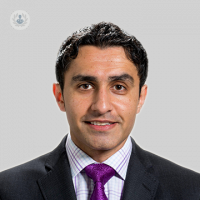Understanding how the nose and ears work together
Autore:The Eustachian tube (ET) connects the middle ear with the back of the nose. It allows the equalisation of pressure on either side of the eardrum and drainage of fluid from the middle ear, which is essential for hearing. When swallowing the Eustachian tube opens allowing air to enter the middle ear space. Mr Ravinder Singh Natt is a leading otolaryngologist with huge experience in treating conditions of the Eustachian tube and here he explains them.
What problems can occur in the ET?
If the ET does not open correctly or is blocked (dilatory ET dysfunction), symptoms include:
- Reduced hearing
- Earache
- Dizziness
- A sensation of fullness within the ear
- Tinnitus
Blockages can occur following a chest infection or with rhinitis.
If the ET cannot close correctly (palatal ET dysfunction), symptoms may include:
- Cracking and popping in the ear
- Hearing your own voice (autophony)
- Disruptive nasal breathing
These can vary with different head positions. In adults, an ET dysfunction doesn’t last long, but, if it persist treatment is needed. If left untreated, damage to the eardrum and middle ear can result.
How are these treated?
All patients should be assessed by an ENT surgeon, with an audiogram (measures hearing thresholds) and a tympanogram (checks middle ear pressure) completed.
Treatments improve ventilation and include:
- Oral / nasal steroids
- Decongestants
- Antihistamines
These improve the ventilation of the ET opening. If needed, a Valsalva manoeuvre is done whereby the ET is reopened by raising pressure in the nose through an auto-inflation technique of forced exhalation against a closed mouth and nose.
If needed, insertion of a ventilation grommet tube through a small incision in the eardrum is recommended to equalise the pressure on each side of the ear drum.
For palatal ET dysfunction, surgery to narrow the Et opening can be done, either by injecting filling agents or inserting implants.
What is balloon dilation?
For patients experiencing dilatory ET dysfunction, a new technique of balloon dilation is now available. This involves the cannulation of the cartilaginous portion of the ET through the posterior aspect of the nasal cavity with a balloon catheter. This catheter is inflated to multiple atmospheres of pressure for a short period and then removed, achieving dilation. It is performed with sedation or general anaesthetic. This requires a nasal endoscope for guidance. If pre-existing narrowing of access to the nasopharynx exists, then extra surgical intervention will be considered.
Side-effects of minor nose bleeds and rarely infection have been reported, but there is strong evidence that this allows significant improvements in quality of life in patients.
If you are concerned about your are concerned at al about your ENT health, make an appointment with a specialist.



